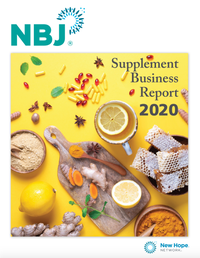
As part of Nutrition Business Journal’s Global Issue, Matthew Oster, head of consumer health at Euromonitor International, introduces his perspective on what’s happening in the dietary supplement industry around the globe, the impacts of COVID-19 and how other trends are playing out regionally. Read the full interview with Oster below.
How has the global dietary supplements market changed since the onset of COVID-19?
The marketplace for dietary supplements before the COVID-19 pandemic was strong and growing globally. From 2014 to 2019, vitamins and dietary supplements saw a global compound annual growth rate of 3%, according to Euromonitor International, with growth strong in all regions. This solid, consistent trend was undercut slightly in 2019; not for structural reasons, but due to a one-time crackdown in China on direct sellers, the largest channel for vitamins and dietary supplements in that leading market. Despite this hiccup, the global marketplace entered 2020 primed for strong growth.
The COVID-19 pandemic supercharged Euromonitor’s expectations for a strong rebound in 2020. Global consumers reached to vitamins and dietary supplements to meet both acute and general health concerns, and prevention, nutrition and wellness became universal needs with COVID-19 front of mind. As a result, Euromonitor expects global growth to accelerate from just 1% in 2019 to over 4% for full-year 2020. Interest in these products that started in spring 2020 will not abate as long as COVID-19 continues to drive consumer purchasing patterns.
Which regions/countries were demonstrating the fastest growth before COVID-19, and how is that expected to change in 2020?
Emerging economies led the charge toward vitamins and dietary supplements in the five years before COVID-19, largely on the back of improving macroeconomies. Rising rates of per capita disposable income and penetration of vitamins and dietary supplements are positively correlated, as consumers with more means are able to think longer-term about their health and wellness. Economic gains across emerging economies, from 2014 to 2019, allowed for sustained high growth across Middle East and Africa, Latin America and Southeast Asia.
In the Great Recession of 2008, Nutrition Business Journal reported increased supplement usage in the U.S. What are you seeing and anticipating in the global market in the current economic downturn?

What categories performed well before COVID-19, and will those vitamins and dietary supplements continue on that trajectory?
Before COVID-19, global demand for vitamins and dietary supplements centered around concerns related to aging (given the traditional profile of a consistent user of these products). The fastest-growing categories globally included glucosamine (for joint health), probiotics (for digestion), eye health products and general health-oriented products like multi-ingredient tonics. Products also oriented for children (multivitamins, probiotics) proved quite popular, especially in Asia.
With COVID-19, consumers have moved decidedly to vitamins and dietary supplements positioned around immunity (vitamin C, vitamin D, echinacea, ginseng, probiotics), as well as general health products like basic multis. Though the dominant ingredients for immunity change in each region, the overall response has been consistent across the world: After COVID-19 hit, consumers ran to immunity products.
How is COVID-19 affecting distribution globally versus regionally?
Due to lockdowns and restrictions put in place across the world as a response to COVID-19, distribution of vitamins and dietary supplements is expected to shift dramatically in 2020. Sales through e-commerce has seen an across-the-board rise during COVID-19, with the channel expected to take 21% of global vitamins and dietary supplement sales in 2020 compared to 17% in 2019, according to Euromonitor. E-commerce will be the biggest global channel for this category in 2020, outpacing sales from chemists/pharmacies, drugstores/parapharmacies and direct selling. Direct selling, in particular, is expected to see a soft 2020 due to gathering restrictions, as well as a shift from in-person sales to direct-to-consumer e-commerce for the channel.
Putting COVID-19 aside, how have herbal and traditional dietary supplements shifted in recent years?
Herbal and traditional dietary supplements have seen remarkably similar growth as a broader category in recent years. Long-standing cultural usage in areas like East and South Asia has expanded westward to the U.S. and, to a lesser degree, Europe. That said, at this stage, the herbal and traditional dietary supplement landscape is still largely dependent on Asia Pacific, as the region represents over 54% of total sales (and China taking 20% of sales), according to Euromonitor.
There has been an uptick in global growth of herbal and traditional dietary supplements this year, as consumers gravitate more toward ingredients that have an association with immunity, from Traditional Chinese Medicine ingredients like lingzhi and reishi mushrooms to Ayurvedic products like turmeric, tulsi or chyawanprash. In the U.S. this trend also has occurred, with products like elderberry and echinacea struggling to stay on the shelves at the height of the pandemic.
What are generational supplement usage behaviors across the globe?
Adherence to vitamins and dietary supplements traditionally varies drastically by age: The older the consumer, the more likely they will consistently use vitamins and dietary supplements. Euromonitor International’s Health and Nutrition Survey 2020 (fielded pre-COVID-19) showed that global respondents aged 60+ were twice as likely to take vitamins and dietary supplements daily or almost every day (32% of global respondents) compared to respondents aged 15 to 29 (just 16%). As a result, the aging global society in recent years has benefitted the vitamins and dietary supplements marketplace.
Are there notable differences in what influences consumers in different countries and regions to purchase vitamins and dietary supplements?
Euromonitor International’s Health and Nutrition Survey 2020 found that a plurality of vitamins and dietary supplement consumers use these products for general health concerns, followed by immune system support, with almost one-third of global respondents reporting usage of these positioned products. A majority of global respondents also indicated that they consider vitamins and dietary supplements to be important to their overall health and nutrition. These pre-COVID-19 sentiments have likely deepened during the pandemic, as immunity and general health are proving to be the fastest-growing and most consistent categories globally.
Nutrition Business Journal is reporting significant increases in alternate (non-pill) delivery formats in the U.S. What’s happening elsewhere on the globe?
Globally, pill-based formats (pills/capsules/gels) dominate the vitamins and dietary supplements marketplace, with almost 80% of global respondents from Euromonitor’s aforementioned survey reporting usage of this format. However, consumer demand is changing rapidly. As with the U.S., gummies are becoming a more common sighting in markets throughout Asia and command a premium price compared to pill-based forms. More ubiquitous, though, are powder and liquid versions.
These formats predominate in many markets globally, especially in Asia, where concentrated tonics for energy and immunity have been a common staple of convenience stores across the region for years. Powders are also becoming more ever-present in markets like India and China, where supplement ingredients can be added to frequently consumed beverages like tea.

About the Author(s)
You May Also Like





